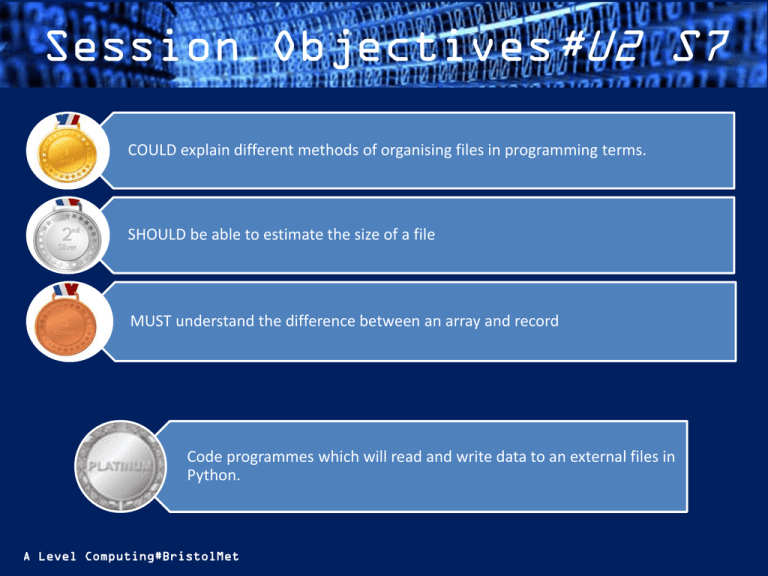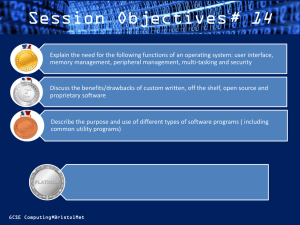ALevelComputing_Session7
advertisement

Session Objectives#U2 S7 COULD explain different methods of organising files in programming terms. SHOULD be able to estimate the size of a file MUST understand the difference between an array and record Code programmes which will read and write data to an external files in Python. A Level Computing#BristolMet Key Words A Level Computing#BristolMet File Organisation When programme files are created, the data used in that file is stored in different ways. Serial file – the data is stored in the order which it arrives. New data is added to the end, which is called appending. (e.g like a shopping list, would be a non computerised serial file) Sequential file – data is stored according to a key field in the data that can be used to identify each individual record, like an ID field. Adding new items requires the file to be recreated as the new data needs to be inserted in the correct position with the records and not simply added to the end. (e.g a class register would be a non computerised sequential file) Indexed Sequential – are sequential but have an index which allows records to be found directly. Random files – In all of the above examples, records are stored next to each other. A random file allows the data to be stored anywhere in a dedicated section of the disk. The location of the field is decided by a calculation called a hash algorithm. Finding these files is very quick, if you know the algorithm and key field, therefore random files are useful for large databases. A Level Computing#BristolMet File Handling Operations It is often useful to programme data in an external file, this requires the use of file operations to prepare, read and write to file Preparing a file – most languages use the OPEN command and specify file name/path. Read data from file – commands differ from among languages but simplest way is to read one line at a time from a serial/sequential files. For random files, lines are read from specific address given in the code. Writing data: This can merging (combining in new and old) as in sequential files, or appending (adding to the end) as in serial files. A Level Computing#BristolMet File Writing Operations TASK: Use the writetofile program and experiment creating different text files with different lines of text by changing the commands. TASK 2: Create an external text file, with a suitable filename, containing the first 2 verses of a song or poem. NB Make sure you have a line break between the 2 verses. EXT: Extend your calculator programmes so that the answers are written to an external file. (The file should contain some explanatory text, ie The Answer = … A Level Computing#BristolMet Estimating File Sizes It is possible to estimate the size of a file by calculating the following: • The size (in bytes) of each field in the record (for a string use the largest size allowed) • Add the field sizes to calculate the size of one record. • Multiply the size of one record by the number of records in the file • Add 10% to the result, for additional storage that will be needed to manage the file on disk (this is call an overhead). TASK: Attempt Q2 on p.97 of the Hodder book. A Level Computing#BristolMet











